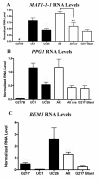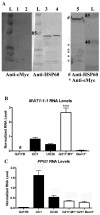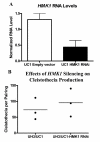Insertional mutagenesis enables cleistothecial formation in a non-mating strain of Histoplasma capsulatum
- PMID: 20158914
- PMCID: PMC2834667
- DOI: 10.1186/1471-2180-10-49
Insertional mutagenesis enables cleistothecial formation in a non-mating strain of Histoplasma capsulatum
Abstract
Background: Histoplasma capsulatum is a pathogenic ascomycete fungus that rapidly loses mating ability in culture. Loss of mating ability, as well as the organism's low rate of targeted gene replacement, limits techniques available for genetic studies in H. capsulatum. Understanding molecular mechanisms regulating mating in this organism may allow us to reverse or prevent loss of mating in H. capsulatum strains, introducing a variety of classical genetics techniques to the field. We generated a strain, UC1, by insertional mutagenesis of the laboratory strain G217B, and found that UC1 acquired the ability to form mating structures called cleistothecia. The aim of this study was to determine the mechanism by which UC1 gained the ability to form cleistothecia. We also present initial studies demonstrating that UC1 can be used as a tool to determine molecular correlates of mating in H. capsulatum.
Results: The strain UC1 was found to have increased RNA levels of the mating locus transcription factor (MAT1-1-1), and the putative alpha pheromone (PPG1) compared to G217B. Agrobacterium-mediated transformation and integration of T-DNA from the vector pCB301-GFP-HYG were found to be partially responsible for the increased RNA levels of these genes; however, the site of integration appeared to play the largest role in the strain's ability to form cleistothecia. Silencing HMK1, a putative FUS3/KSS1 homolog, had no effect on cleistothecial production by UC1. Protein kinase C (PKC1) RNA and protein levels were increased in UC1 compared to G217B, and pheromone production was found to be linked with Pkc1 activity in H. capsulatum.
Conclusions: The site of the T-DNA integration event appears to play the largest role in UC1's ability to form cleistothecia. We show that the UC1 strain can be used as a tool to study cleistothecia production in H. capsulatum by manipulating the strain, or by identifying differences between UC1 and G217B. Using these approaches, we were able to link Pkc1 activity with pheromone production in H. capsulatum; however, further studies are required to determine molecular mechanisms behind this. These studies may reveal regulatory mechanisms that can be manipulated to restore mating ability in H. capsulatum laboratory strains.
Figures









Similar articles
-
VEA1 is required for cleistothecial formation and virulence in Histoplasma capsulatum.Fungal Genet Biol. 2012 Oct;49(10):838-46. doi: 10.1016/j.fgb.2012.07.001. Epub 2012 Jul 24. Fungal Genet Biol. 2012. PMID: 22841690
-
The MAT1 locus of Histoplasma capsulatum is responsive in a mating type-specific manner.Eukaryot Cell. 2007 Apr;6(4):616-21. doi: 10.1128/EC.00020-07. Epub 2007 Feb 23. Eukaryot Cell. 2007. PMID: 17322347 Free PMC article.
-
Extracellular Vesicle-Mediated RNA Release in Histoplasma capsulatum.mSphere. 2019 Mar 27;4(2):e00176-19. doi: 10.1128/mSphere.00176-19. mSphere. 2019. PMID: 30918062 Free PMC article.
-
Sexual variability in Histoplasma capsulatum and its possible distribution: what is going on?Rev Iberoam Micol. 2014 Jan-Mar;31(1):7-10. doi: 10.1016/j.riam.2013.10.002. Epub 2013 Nov 18. Rev Iberoam Micol. 2014. PMID: 24262630 Review.
-
Molecular mycology: a genetic toolbox for Histoplasma capsulatum.Trends Microbiol. 2001 Nov;9(11):541-6. doi: 10.1016/s0966-842x(01)02204-1. Trends Microbiol. 2001. PMID: 11825714 Review.
Cited by
-
Experimental annotation of the human pathogen Histoplasma capsulatum transcribed regions using high-resolution tiling arrays.BMC Microbiol. 2011 Sep 29;11:216. doi: 10.1186/1471-2180-11-216. BMC Microbiol. 2011. PMID: 21958208 Free PMC article.
-
An Indian lineage of Histoplasma with strong signatures of differentiation and selection.Fungal Genet Biol. 2022 Jan;158:103654. doi: 10.1016/j.fgb.2021.103654. Epub 2021 Dec 21. Fungal Genet Biol. 2022. PMID: 34942368 Free PMC article.
-
Spectrum of T-DNA integrations for insertional mutagenesis of Histoplasma capsulatum.Fungal Biol. 2013 Jan;117(1):41-51. doi: 10.1016/j.funbio.2012.11.004. Epub 2012 Dec 2. Fungal Biol. 2013. PMID: 23332832 Free PMC article.
-
Frequency of the Mating-Type (MAT1) in Histoplasma capsulatum Isolates from Buenos Aires, Argentina.Mycopathologia. 2020 Feb;185(1):169-174. doi: 10.1007/s11046-019-00402-2. Epub 2019 Oct 31. Mycopathologia. 2020. PMID: 31667672
-
Frequency and genetic diversity of the MAT1 locus of Histoplasma capsulatum isolates in Mexico and Brazil.Eukaryot Cell. 2013 Jul;12(7):1033-8. doi: 10.1128/EC.00012-13. Epub 2013 May 24. Eukaryot Cell. 2013. PMID: 23709181 Free PMC article.
References
-
- Meals LT, McKinney WP. Acute pulmonary histoplasmosis: progressive pneumonia resulting from high inoculum exposure. J Ky Med Assoc. 1998;96:258–260. - PubMed
Publication types
MeSH terms
Substances
LinkOut - more resources
Full Text Sources

